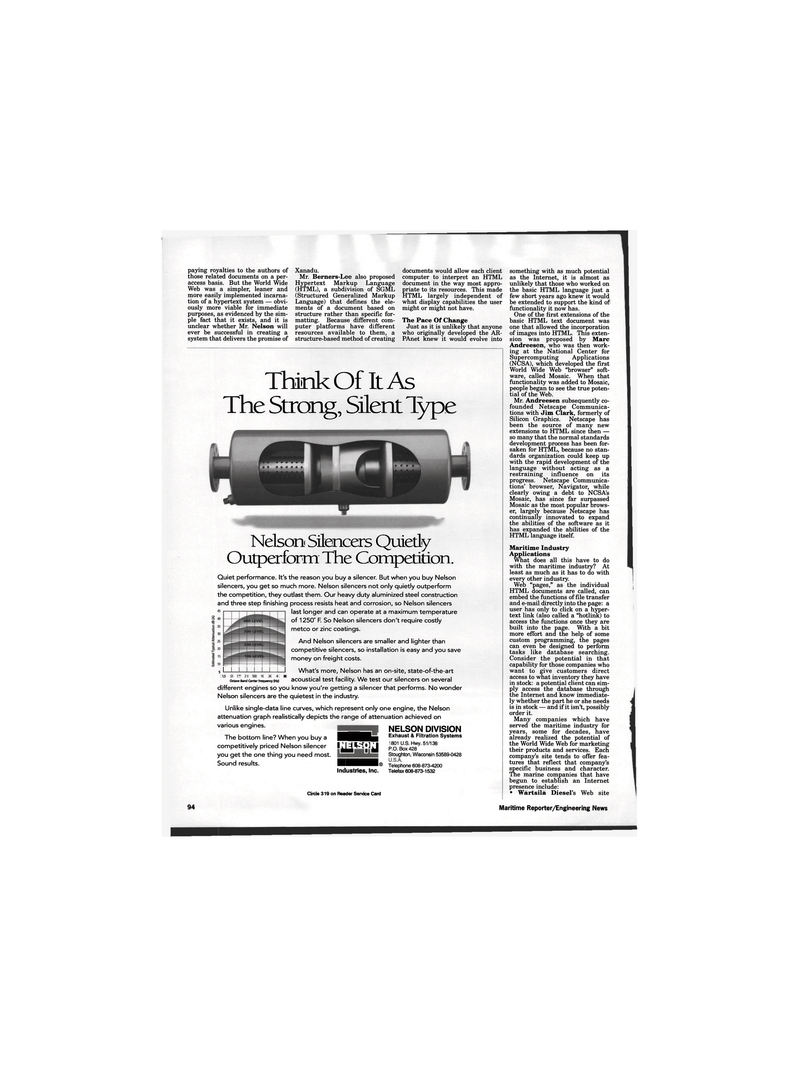
Page 108: of Maritime Reporter Magazine (June 1996)
Read this page in Pdf, Flash or Html5 edition of June 1996 Maritime Reporter Magazine
paying royalties to the authors of those related documents on a per- access basis. But the World Wide
Web was a simpler, leaner and more easily implemented incarna- tion of a hypertext system — obvi- ously more viable for immediate purposes, as evidenced by the sim- ple fact that it exists, and it is unclear whether Mr. Nelson will ever be successful in creating a system that delivers the promise of
Xanadu.
Mr. Berners-Lee also proposed
Hypertext Markup Language (HTML), a subdivision of SGML (Structured Generalized Markup
Language) that defines the ele- ments of a document based on structure rather than specific for- matting. Because different com- puter platforms have different resources available to them, a structure-based method of creating
Industries, Inc.
Circle 319 on Reader Service Card documents would allow each client computer to interpret an HTML document in the way most appro- priate to its resources. This made
HTML largely independent of what display capabilities the user might or might not have.
The Pace Of Change
Just as it is unlikely that anyone who originally developed the AR-
PAnet knew it would evolve into something with as much potential as the Internet, it is almost as unlikely that those who worked on the basic HTML language just a few short years ago knew it would be extended to support the kind of functionality it now has.
One of the first extensions of the basic HTML text document was one that allowed the incorporation of images into HTML. This exten- sion was proposed by Marc
Andreesen, who was then work- ing at the National Center for
Supercomputing Applications (NCSA), which developed the first
World Wide Web "browser" soft- ware, called Mosaic. When that functionality was added to Mosaic, people began to see the true poten- tial of the Web.
Mr. Andreesen subsequently co- founded Netscape Communica- tions with Jim Clark, formerly of
Silicon Graphics. Netscape has been the source of many new extensions to HTML since then — so many that the normal standards development process has been for- saken for HTML, because no stan- dards organization could keep up with the rapid development of the language without acting as a restraining influence on its progress. Netscape Communica- tions' browser, Navigator, while clearly owing a debt to NCSA's
Mosaic, has since far surpassed
Mosaic as the most popular brows- er, largely because Netscape has continually innovated to expand the abilities of the software as it has expanded the abilities of the
HTML language itself.
Maritime Industry
Applications
What does all this have to do with the maritime industry? At least as much as it has to do with every other industry.
Web "pages," as the individual
HTML documents are called, can embed the functions of file transfer and e-mail directly into the page: a user has only to click on a hyper- text link (also called a "hotlink) to access the functions once they are built into the page. With a bit more effort and the help of some custom programming, the pages can even be designed to perform tasks like database searching.
Consider the potential in that capability for those companies who want to give customers direct access to what inventory they have in stock: a potential client can sim- ply access the database through the Internet and know immediate- ly whether the part he or she needs is in stock — and if it isn't, possibly order it.
Many companies which have served the maritime industry for years, some for decades, have already realized the potential of the World Wide Web for marketing their products and services. Each company's site tends to offer fea- tures that reflect that company's specific business and character.
The marine companies that have begun to establish an Internet presence include: • Wartsila Diesel's Web site
Think Of It As
The Strong, Silent Type
Nelson Silencers Quietly
Outperform The Competition.
Quiet performance. It's the reason you buy a silencer. But when you buy Nelson silencers, you get so much more. Nelson silencers not only quietly outperform the competition, they outlast them. Our heavy duty aluminized steel construction and three step finishing process resists heat and corrosion, so Nelson silencers last longer and can operate at a maximum temperature of 1250° F. So Nelson silencers don't require costly metco or zinc coatings.
And Nelson silencers are smaller and lighter than competitive silencers, so installation is easy and you save money on freight costs. 5 I—I—I—I—I—I—I—i—I What's more, Nelson has an on-site, state-of-the-art 1 ortave~Band'center Frequency (Hz) * acoustical test facility. We test our silencers on several different engines so you know you're getting a silencer that performs. No wonder
Nelson silencers are the quietest in the industry.
Unlike single-data line curves, which represent only one engine, the Nelson attenuation graph realistically depicts the range of attenuation achieved on various engines.NELSON DIVISION
The bottom line? When you buy a HHHb Exhaust & Filtration Systems competitively priced Nelson silencer I^WjlJ p^f^ST'51/138 you get the one thing you need most. Stoughton, Wisconsin 53589-0428
Sound results. HHHHH® Telephone 608-873-4200 . Telefax 608-873-1532 94 Maritime Reporter/Engineering News

 107
107

 109
109
